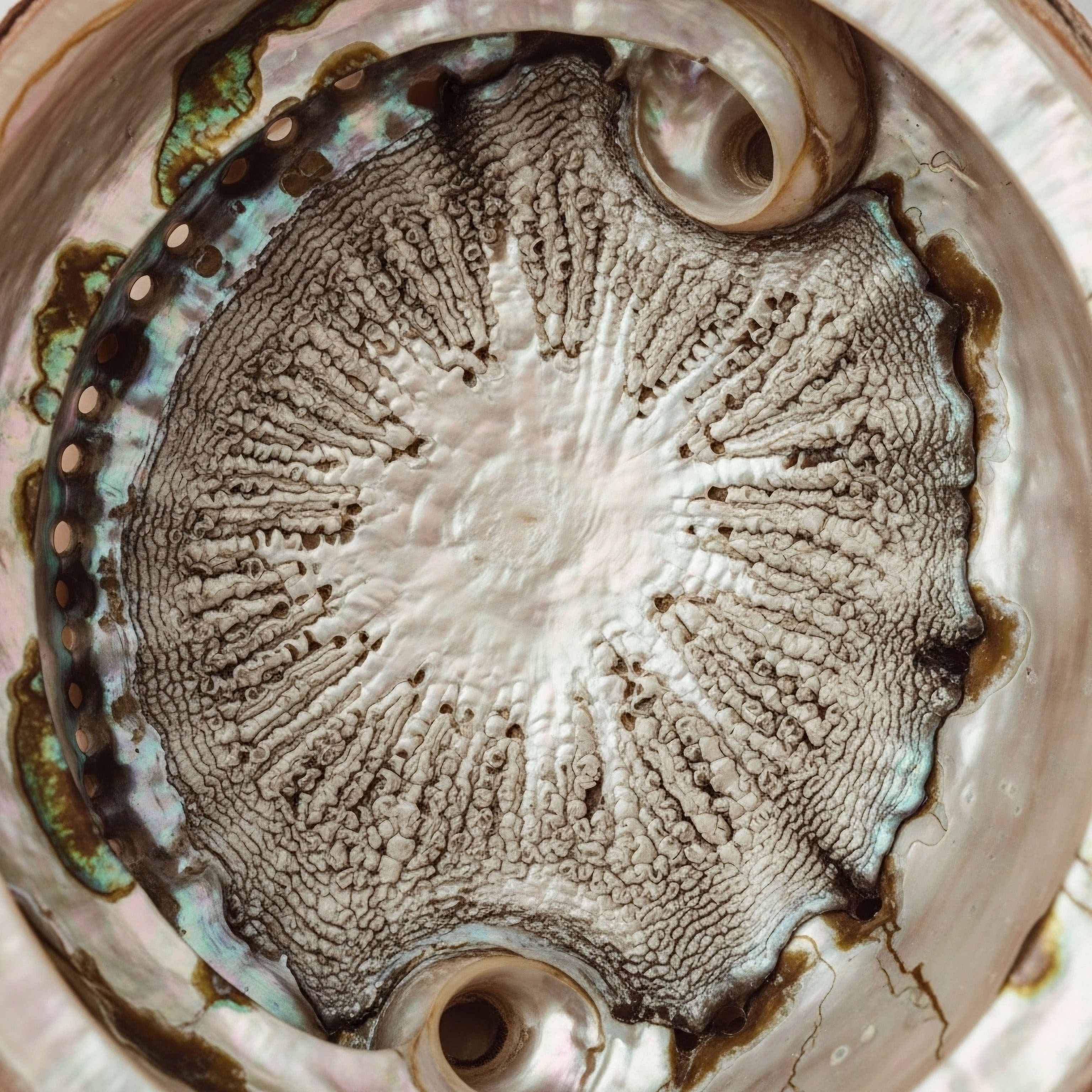

Fundamentals
Beginning a journey with testosterone therapy is a significant step toward reclaiming your vitality. You may feel a sense of anticipation, hoping this clinical intervention will restore the energy and function you remember. This is a valid and common starting point. The clinical protocols, whether Testosterone Replacement Therapy (TRT) or peptides, provide a powerful signal to your body.
Your dietary patterns, however, determine the quality of the environment in which those signals are received and utilized. Think of your body as a complex biological terrain. The therapy is a high-quality seed, full of potential. The food you consume is the soil, the water, and the nutrients that determine whether that seed flourishes or struggles.
The conversation between your plate and your endocrine system is constant and profound. Hormones, including testosterone, are synthesized from raw materials you provide through your diet. The very foundation of testosterone is cholesterol, a lipid molecule. This means that dietary fats are the essential precursors for hormonal production.
A diet chronically low in healthy fats can deprive your body of the fundamental building blocks needed to construct these vital messengers. This is a core principle of endocrine health. Your body requires specific nutrients to execute the complex biochemical conversions that lead to optimized hormone levels. When these are absent, the system’s efficiency is compromised, even when external hormones are introduced.
Your diet provides the foundational building blocks and the metabolic environment that dictate the success of hormonal therapy.
The food you eat does more than just supply calories; it delivers information. It instructs your genes, modulates inflammation, and influences the intricate feedback loops that govern your entire hormonal cascade. A diet rich in processed foods, sugars, and industrial seed oils sends signals of stress and inflammation throughout your body.
This inflammatory state creates a chaotic internal environment that can interfere with hormone receptor sensitivity. In essence, the therapeutic signals from your treatment may be sent, but the body’s ability to “hear” and respond to them is muffled by metabolic noise.
Conversely, a nutrient-dense diet communicates a message of balance and stability, creating a terrain where therapeutic interventions can achieve their maximum effect. Understanding this dynamic shifts your perspective. You become an active participant in your wellness, using nutrition as a precise tool to support your body’s recalibration.

The Architecture of Hormonal Health
Your body’s hormonal system is built upon the Hypothalamic-Pituitary-Gonadal (HPG) axis. This is the command-and-control pathway for testosterone production. The hypothalamus releases Gonadotropin-Releasing Hormone (GnRH), which signals the pituitary to release Luteinizing Hormone (LH) and Follicle-Stimulating Hormone (FSH).
LH then travels to the testes, instructing the Leydig cells to produce testosterone. This entire elegant system is metabolically expensive and nutrient-dependent. Specific vitamins and minerals act as essential cofactors in these enzymatic processes. Deficiencies in key micronutrients can create bottlenecks in this production line. Therefore, your daily food choices directly support or hinder the efficiency of this primary axis, influencing both your baseline hormonal status and your response to therapies designed to support it.


Intermediate
To optimize the outcomes of hormonal therapy, we must move beyond general dietary advice and examine the specific roles of macronutrients and micronutrients in modulating endocrine function. The composition of your meals directly influences the biochemical environment of your body, which can either amplify or attenuate the effects of treatments like TRT. This requires a more granular understanding of how proteins, fats, and carbohydrates are processed and the downstream effects they have on hormonal pathways.
Protein intake is critical for supporting the primary anabolic benefit of testosterone, which is the synthesis of muscle tissue. Adequate high-quality protein provides the necessary amino acids for muscle repair and growth. Healthy fats perform a different, yet equally important, function.
Monounsaturated and polyunsaturated fats, found in foods like avocados, olive oil, and nuts, are the direct precursors for steroidogenesis, the multi-step process that converts cholesterol into testosterone. Carbohydrate quality dictates insulin response, a key metabolic regulator. High-glycemic, processed carbohydrates lead to sharp insulin spikes.
Chronic insulin elevation is linked to increased inflammation and lower levels of Sex Hormone-Binding Globulin (SHBG), which results in less available free testosterone. A diet centered on whole, nutrient-dense foods creates the ideal metabolic foundation for hormonal health.

Macronutrient Strategies for Hormonal Support
A strategic approach to macronutrient consumption is essential during and after hormonal therapy. The goal is to provide the building blocks for hormone production, support the intended effects of the therapy, and manage potential side effects through nutrition. The following table illustrates two contrasting dietary patterns and their physiological impact.
| Dietary Approach | Primary Food Sources | Metabolic & Hormonal Impact |
|---|---|---|
| Hormone-Supportive Pattern | Lean proteins (fish, chicken), healthy fats (avocado, olive oil, nuts), fibrous vegetables, and whole grains. | Promotes stable insulin levels, reduces inflammation, provides essential fatty acids for steroidogenesis, and supplies micronutrient cofactors. Supports higher levels of SHBG and improves receptor sensitivity. |
| Hormone-Disruptive Pattern | Ultra-processed foods, sugary beverages, refined grains (white bread, pastries), and industrial seed oils. | Causes insulin resistance, promotes chronic inflammation, increases aromatase activity (conversion of testosterone to estrogen), and can lead to nutrient deficiencies. Reduces SHBG, lowering free testosterone. |

What Is the Role of Micronutrients in Testosterone Synthesis?
While macronutrients provide the fuel and building blocks, micronutrients are the spark plugs that drive the enzymatic reactions of hormone production. Several vitamins and minerals are indispensable for the testosterone synthesis pathway. Deficiencies in these key areas can create significant bottlenecks, limiting both natural production and the body’s ability to effectively use administered testosterone.
- Zinc This mineral is a critical cofactor for enzymes involved in testosterone synthesis. It plays a direct role in the function of the Leydig cells in the testes where testosterone is produced. Food sources include oysters, lean red meat, and pumpkin seeds.
- Vitamin D Functioning as a pro-hormone, Vitamin D receptors are found in endocrine tissues, including the testes. Clinical data suggests a strong correlation between Vitamin D levels and circulating testosterone. Sun exposure and supplementation are the most effective ways to ensure adequate levels.
- Magnesium This mineral is involved in hundreds of enzymatic reactions, including those related to testosterone production. It also appears to influence the bioavailability of testosterone by affecting SHBG. Leafy green vegetables, nuts, and seeds are excellent sources.
Ensuring adequate intake of these micronutrients through a whole-foods diet or targeted supplementation is a non-negotiable aspect of a comprehensive hormonal optimization protocol. It addresses the foundational biochemistry that allows your body to thrive.


Academic
A sophisticated analysis of the relationship between diet and testosterone levels, particularly within the context of hormonal therapy, requires a deep examination of the interplay between metabolic inflammation, insulin signaling, and enzymatic conversion pathways. The effectiveness of exogenous testosterone administration can be profoundly influenced by the patient’s underlying metabolic milieu.
A diet high in refined carbohydrates and pro-inflammatory fats establishes a systemic environment conducive to insulin resistance and chronic low-grade inflammation. This state directly impacts testosterone bioavailability and metabolism through the upregulation of the aromatase enzyme and the modulation of Sex Hormone-Binding Globulin (SHBG).

The Insulin-Inflammation-Aromatase Axis
Insulin resistance, a condition precipitated by diets rich in high-glycemic foods, is a central antagonist to testosterone optimization. Elevated circulating insulin levels, a hallmark of this condition, contribute to increased adiposity, particularly visceral adipose tissue (VAT). VAT is a metabolically active organ that functions as a site of significant inflammation, secreting cytokines like TNF-alpha and Interleukin-6.
These inflammatory cytokines, in turn, promote the activity of aromatase, the enzyme responsible for the peripheral conversion of androgens (testosterone) into estrogens (estradiol). This creates a self-perpetuating cycle where a poor diet increases visceral fat, which then elevates aromatase activity, leading to lower testosterone and higher estrogen levels. This directly counteracts the primary goal of TRT, effectively converting the therapeutic testosterone into estrogen.
A pro-inflammatory diet high in processed foods can systematically convert therapeutic testosterone into estrogen, undermining the goals of therapy.
This biochemical reality explains why some individuals on a standardized TRT protocol experience suboptimal results or develop estrogenic side effects like gynecomastia or water retention. Their dietary pattern is actively working against the therapy at a cellular level.
Addressing the diet is therefore a primary clinical intervention for managing aromatase activity, often preceding or complementing the use of anastrozole or other aromatase inhibitors. A dietary pattern low in processed foods and rich in anti-inflammatory omega-3 fatty acids can downregulate this inflammatory cascade, reduce aromatase expression, and thus preserve circulating testosterone.

How Does Nutrition Influence the Hypothalamic Pituitary Gonadal Axis?
The regulatory integrity of the Hypothalamic-Pituitary-Gonadal (HPG) axis is metabolically sensitive. After cessation of TRT, a key goal is to restore endogenous production, a process governed by this axis. Nutritional status plays a direct role. For instance, leptin, a hormone secreted by adipose tissue, provides feedback to the hypothalamus regarding energy stores.
A state of chronic caloric deficit or nutrient deficiency can suppress hypothalamic GnRH pulses, leading to secondary hypogonadism. A diet that promotes a healthy body composition ensures proper leptin signaling, which is permissive for HPG axis function. Furthermore, the synthesis of neurotransmitters that modulate GnRH release, such as kisspeptin, is also dependent on nutrient availability. Therefore, a nutrient-dense dietary pattern is a prerequisite for the successful recovery of the HPG axis post-therapy.
The following table details key micronutrients and their specific roles as cofactors in the steroidogenesis pathway, highlighting the molecular necessity of a nutrient-replete diet for anyone on or coming off hormonal therapy.
| Micronutrient | Biochemical Role in Steroidogenesis | Clinical Significance for Hormonal Therapy |
|---|---|---|
| Zinc | Cofactor for 3-beta-HSD and 17-beta-HSD enzymes, which are critical for converting pregnenolone to DHEA and androstenedione to testosterone. | A deficiency can create a direct bottleneck in the testosterone production pathway, limiting both endogenous recovery and the body’s ability to process hormonal precursors. |
| Vitamin D | Acts as a signaling molecule in Leydig cells. Its active form, calcitriol, modulates the expression of genes involved in steroidogenesis. | Low levels are correlated with lower total and free testosterone. Optimizing Vitamin D status is a foundational step in supporting testicular function. |
| Selenium | Essential component of selenoproteins, which have antioxidant functions within the testes, protecting Leydig cells from oxidative stress and apoptosis. | Preserves the health and function of the testosterone-producing cells, which is vital for both baseline production and long-term testicular health during protocols using Gonadorelin. |
| Boron | Appears to decrease SHBG levels and may reduce the urinary excretion of testosterone, thereby increasing free testosterone concentrations. | May enhance the bioavailability of both endogenous and exogenous testosterone, making the therapy more efficient. |

References
- Whittaker, J. & Wu, K. (2021). Low-fat diets and testosterone in men ∞ Systematic review and meta-analysis of intervention studies. The Journal of Steroid Biochemistry and Molecular Biology, 210, 105878.
- Chang, C. S. Choi, J. B. Kim, K. C. & Park, S. B. (2018). Testosterone-Associated Dietary Pattern Predicts Low Testosterone Levels and Hypogonadism. The World Journal of Men’s Health, 36(3), 219 ∞ 227.
- Skoracka, K. Eder, P. Łykowska-Szuber, L. Dobrowolska, A. & Krela-Kaźmierczak, I. (2020). Diet and Nutritional Factors in Male (In)fertility ∞ Underestimated Factors. Journal of Clinical Medicine, 9(5), 1400.
- Te, L. & Liu, J. (2023). An evidence-based perspective on dietary patterns and supplements in the management of male-factor infertility. Asian Journal of Andrology, 25(3), 343 ∞ 352.
- D’Andrea, S. Spaggiari, G. & Santi, D. (2021). The role of diet in the management of testosterone deficiency. Reviews in Endocrine and Metabolic Disorders, 22(4), 837 ∞ 850.

Reflection

Calibrating Your Internal Environment
You have now seen the deep connections between your dietary choices and your hormonal health. This knowledge is a powerful tool. It reframes your daily meals as a form of biological communication, a way to continuously shape the internal landscape of your body.
The path forward involves moving from passively receiving a therapy to actively building a foundation that allows it to succeed. Consider your own plate. What messages are you sending to your endocrine system? Are you providing the raw materials for vitality or the signals of inflammation?
This understanding is the first, most important step. The application of this knowledge is a personal process of recalibration. It requires awareness, consistency, and a willingness to see your health as an integrated system. The ultimate goal is to create an internal environment where your body can function with precision and resilience. Your journey is unique, and the thoughtful application of these principles is what will define your personal success.

Glossary

testosterone replacement therapy

dietary patterns

leydig cells

hormonal therapy

steroidogenesis

sex hormone-binding globulin

free testosterone

shbg

insulin resistance

therapeutic testosterone into estrogen

aromatase activity

hpg axis




